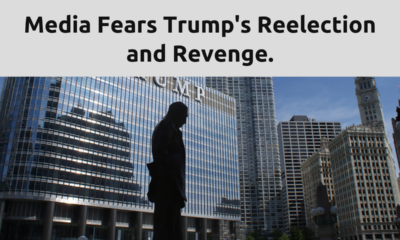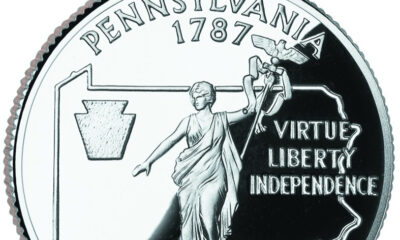Executive
Biden’s Campaign Faces a Manufacturing Disconnect
Made in America manufacturing doesn’t seem to have caught on yet. The head of the biggest Made in America group has some suggestions.

Despite months of falling inflation, wage gains, and a strong labor market, polls consistently show Americans still aren’t confident about the economy – an indicator that many times has forecast the outcome of a presidential election.
That’s obviously tough news for Joe Biden, who isn’t yet receiving credit for our improving economic conditions. What isn’t obvious is what he can do to change voters’ minds about it because his economic message is complicated: “Made in America” manufacturing, on which he has spent lots of political energy and hangs his political hat, hasn’t yet taken flight in ways most Americans can see or sense.
That’s likely about to change.
Factory construction exploded in the United States last year, largely because of the Biden administration’s efforts to enact industrial policy. These are the big, centerpiece legislative victories that Biden can claim, and by this important measure, they have been successful. The combined effects of the trillion-dollar-plus investment for Made in America infrastructure, semiconductor fabrication, and clean energy manufacturing have helped generate enormous investments in plants that will make broadband cable, EV batteries, polysilicon wafers for solar panels, low-carbon steel, and semiconductor chips. Manufacturing-related construction nationwide in 2023 totaled $214 billion through November, which is more than triple the average annual rate of the 2010s.
“There’s a lot more work to do, but there’s no question our plan of investing in America and the American people is working,” the president said on a campaign swing through North Carolina, which alone has seen approximately $31 billion in private industrial investment during his term.
But his reelection campaign won’t take years, it will take months, and the factory jobs that can capture voters’ attention – only 12,000 of them created in 2023 – have not yet followed the investment. Voters, meanwhile, aren’t noticing the factory construction taking place around them. Only 30%, in a national poll conducted last summer, reported seeing, reading, or hearing about new factories coming to their communities.
Several dynamics could improve their visibility and economic opinion in the industrial swing states: continued lower inflation, wage growth, and the arrival of factory jobs to which the president can point. Meanwhile, Biden must evangelize. He would run out of time before appearing at every site in America where a factory is being built. But he should still hit as many as possible.
The president’s instinct is correct; these are jobs worth fighting for. Manufacturing has a strong economic multiplier effect, and the opportunities it generates can mean a steady income for workers with less than a four-year degree, which is a labor pool that includes many millions of Americans. Factory work, especially if it’s unionized or pays good wages, expands the middle class. Stumping for it is good economics as well as good politics because the polling also consistently shows voters want more made in America.
And despite the disconnect between investment and employment that he’s currently faced with, Biden can strike a real contrast here with Donald Trump, who almost certainly will be his reelection opponent. Trump talked endlessly about reshoring manufacturing during his time in office, and he did raise tariffs on Chinese imports, which pushed some production out of China. But Biden has gone further, securing the domestic investment crucial to making the U.S. an attractive industrial destination again. With it, as well as strong trade enforcement and continued tariff maintenance, the federal government has primed the economy for factory hiring, especially now that some companies prioritize supply chain resilience and localization.
It’s important to note this nascent industrial policy is at a crossroads. Some critics – even as they show up for factory ribbon cuttings – want to gut its funding, which would dry up the manufacturing investment. Others want to open the floodgates to more imported EVs and clean energy products and parts to jumpstart the energy transition, which would put a nail in the coffin of the effort to make it homegrown. Free trade enthusiasts boosted by powerful international business interests are always looking to roll back tariffs. High borrowing costs are stalling some promised new factories.
And yet, the presidential candidate who articulates the most effective “Made in America” approach is likely to resonate more with voters. American manufacturing is on the brink of a new era thanks to industrial policy. That will become more apparent to voters when they see the jobs.
This article was originally published by RealClearPolitics and made available via RealClearWire.
Scott Paul is president of the Alliance for American Manufacturing.
-

 Education5 days ago
Education5 days agoCHAPTER 11: Critical Race Theory: A Species of the Ideological Thought Genus Marxism
Space Is No Longer the Final Frontier—Reality Is [forthcoming release May 2024] -

 Civilization4 days ago
Civilization4 days agoCHAPTER 12: Seeding Race Wars
Space Is No Longer the Final Frontier—Reality Is [forthcoming release May 2024] -

 Civilization5 days ago
Civilization5 days agoWill Trump flip New York?
-

 Education3 days ago
Education3 days agoTitle IX revision sparks State revolts
-

 Constitution2 days ago
Constitution2 days agoPrecinct Strategy scores again
-

 Clergy5 days ago
Clergy5 days agoHistorical Points Have Their Place, But That Is Not Where Your Faith Is To Stand!
-

 Education4 days ago
Education4 days agoDid the Freemasons, Illuminati, Spiritualists and Mystics establish this country?
-

 Civilization1 day ago
Civilization1 day agoLegacy media already assume Trump wins














